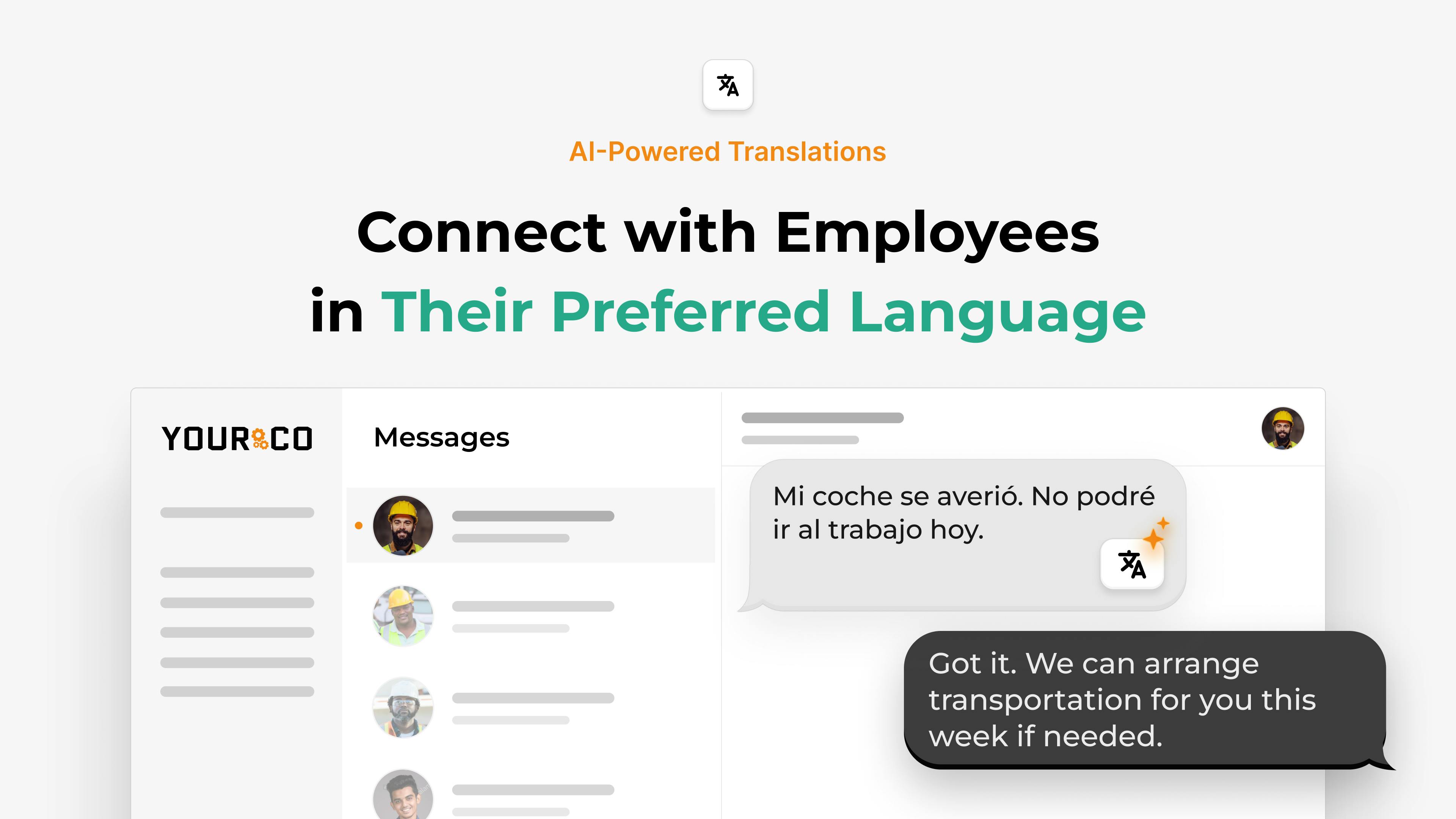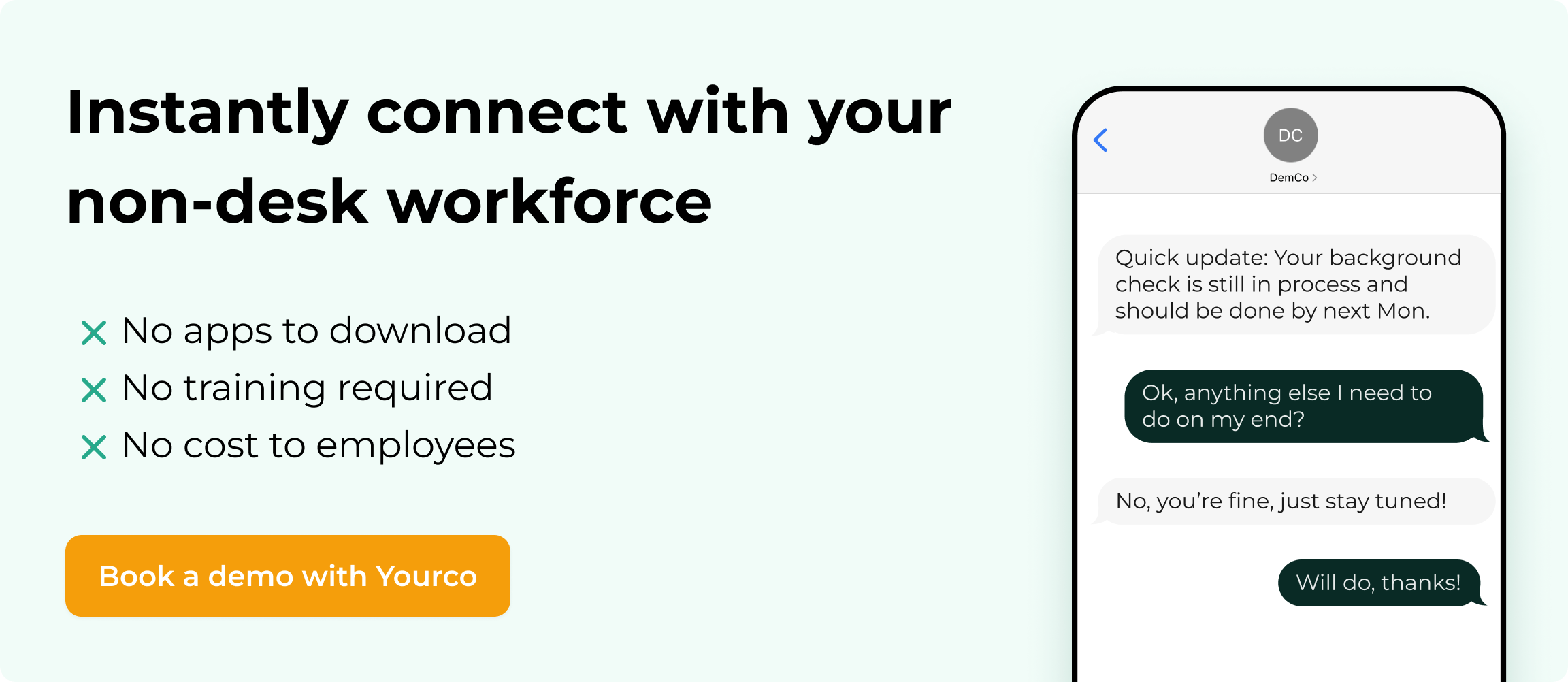How to Bridge Communication Gaps with Your Deskless Workforce


For millions of workers who don't sit behind a desk, staying connected to what's happening at work isn't always easy. These are the people on factory floors, in hospital wings, on construction sites, behind the wheel, or moving through busy kitchens. They don't have the luxury of checking email or logging into company portals during the day. Communication can break down because of it, resulting in missed safety updates, confusion around shifts, or employees feeling left out of company decisions and culture.
Many businesses are starting to recognize that their traditional ways of sharing information simply don't work for these teams. What deskless workers need is clear, timely communication that fits into the reality of their workday. No complicated systems, extra apps to download, or relying on internet access. Just messages that arrive when they're needed, in a format that's easy to use and understand.
Challenges Non-Desk Workers Face
Non-desk employees encounter communication barriers that desk-based workers rarely consider. These challenges create significant obstacles to workplace engagement and operational efficiency.
Limited Access to Traditional Communication Channels
Most non-desk workers lack regular access to company emails, internal messaging systems, or desktop computers. Manufacturing workers on the floor, construction crews at job sites, and delivery drivers on routes can't check email throughout their shifts. This creates information silos where critical updates, policy changes, and safety alerts fail to reach the people who need them most.
Language and Cultural Barriers
Many non-desk workforces are highly diverse, with employees speaking different primary languages. Traditional communication methods often fail to bridge these language barriers, leaving some team members excluded from important information. Without proper translation support, safety instructions, benefits information, and company announcements may not be understood by all employees.
Technology Adoption Challenges
While many solutions assume smartphone usage, not all non-desk employees are comfortable with complex technology or have access to reliable internet connections. Asking workers to download apps, remember passwords, or navigate sophisticated interfaces creates additional barriers to communication.
Shift-Based Communication Gaps
Non-desk workers often operate across multiple shifts, locations, and time zones. Information shared during day shifts may never reach evening or overnight teams. Traditional communication methods struggle to ensure consistent message delivery across all work schedules and locations.
What Deskless Teams Actually Need
Understanding the specific requirements of non-desk workers helps create effective communication strategies that truly serve these team members.
Instant, Reliable Message Delivery
Deskless teams need communication that reaches them immediately, regardless of their location or internet connectivity. Safety alerts, schedule changes, and emergency notifications must be delivered without delay. Traditional email systems fall short, with average read rates around 20%, while workers need something more immediate and reliable.
Simple, No-Training-Required Tools
The most effective communication tools for non-desk workers require zero training and work on any device. Complex interfaces and multi-step processes create barriers that prevent adoption. Workers need solutions that feel familiar and intuitive from day one.
Two-Way Communication Capabilities
Frontline employees want to be heard, not just receive broadcasts. They need ways to report safety issues, request time off, ask questions, and provide feedback without complicated processes. This two-way interaction builds trust and helps management stay connected to on-the-ground realities.
Multilingual Support
Diverse workforces require communication tools that speak every employee's language. Automatic translation capabilities ensure that safety protocols, benefits information, and company updates reach everyone clearly, promoting both inclusion and compliance.
Mobile-First Accessibility
While avoiding complex app requirements, the ideal solution works seamlessly on basic mobile phones. This includes flip phones and older smartphones, ensuring no one is excluded due to their device limitations.
Meet Yourco: The SMS Platform Built for Deskless Teams
Yourco addresses the communication challenges and needs mentioned above through a purpose-built SMS platform that connects non-desk employees with their employers efficiently and inclusively.
Two-Way SMS Communication & One-Way Corporate Broadcast Channel
Interactive exchanges between employees and management happen through simple text messaging with Yourco. Workers can voice concerns, ask questions, and receive immediate responses, creating genuine dialogue.
For enterprise needs, the platform also offers a one-way corporate broadcast channel. This allows companies to send company-wide updates, executive messages, and policy changes at scale without expecting or managing replies. All messages are logged for compliance and can be referenced when needed.
AI-Powered Automatic Translations
With support for over 135 languages and dialects, messages are automatically translated based on each employee's preferred language setting. This ensures safety protocols, policy updates, and daily communications reach everyone clearly. The AI uses context-aware translation models specifically designed for workplace communication, reducing errors from workplace terminology and acronyms.
Frontline Intelligence
Yourco’s Frontline Intelligence transforms everyday conversations into powerful, real-time insights. Leaders can prompt the system with simple questions like:
- “Show me top emerging risks by location”
- “Break down attendance, safety issues, and morale trends”
- “Which teams are lagging in HR initiative participation?”
Behind the scenes, Yourco uses AI to analyze message activity, response rates, and sentiment levels. It highlights absenteeism hotspots, safety concerns, and underperforming sites, turning raw data into structured frontline intelligence.
This gives CHROs, COOs, and frontline managers clear visibility into what is happening across teams and shifts. They can see who is responding, who is falling behind, and where support is needed most. Instead of waiting on quarterly reports, leaders can spot issues early, launch retraining efforts, or reinforce what is already working.
Unlimited Messaging and Secure Storage
The platform provides unlimited messaging capabilities with secure, permanent storage of all communications. Whether sending shift reminders, safety alerts, or company announcements, there are no restrictions on volume. All messages are encrypted and stored securely, supporting audit requirements and compliance needs.
Message Scheduling and Automation
Advanced scheduling features allow managers to plan communications in advance, ensuring messages reach workers during optimal times. Automated reminders for shifts, benefits enrollment, and training requirements reduce administrative burden while improving compliance rates.
Enterprise-Grade Security and Integration
With over 240 HRIS and payroll system integrations, the platform syncs seamlessly with existing workplace infrastructure. Role-based permissions ensure the right messages reach the right people. It is also SOC 2 Type II certified and fully GDPR compliant, protecting sensitive employee information with enterprise-grade security.
Key Use Cases That Transform Workplace Communication
Multiple workplace scenarios benefit from Yourco's versatile communication capabilities, demonstrating its practical impact across various situations.
Emergency Alerts and Safety Communication
When emergencies strike, every second counts. Critical safety alerts are delivered instantly via SMS, reaching employees even in areas with limited internet connectivity. Workers can quickly report safety incidents by texting photos and descriptions directly to their company's dedicated number, creating timestamped documentation for follow-up actions.
Shift Management and Attendance
The platform streamlines shift communication by sending automatic reminders and enabling quick absence reporting through the "text off line" feature. When employees can't make their shift, they simply text their company number instead of making phone calls. Managers receive immediate notifications and can respond directly to arrange coverage or ask follow-up questions.
HR Communications and Benefits
Open enrollment periods become more manageable with automated SMS reminders and educational content delivered directly to employees' phones. Benefits information, policy updates, and compliance acknowledgments can be distributed quickly and tracked automatically, ensuring high participation rates and proper documentation.
Employee Surveys and Feedback Collection
Built-in polling features and survey distribution capabilities help gather real-time employee feedback. Whether conducting pulse surveys or collecting input on workplace improvements, SMS-based surveys achieve significantly higher response rates than email alternatives, providing more accurate insights into employee sentiment.
Training and Onboarding Support
New hire onboarding becomes more efficient when important documents, training schedules, and welcome messages are delivered via SMS. Employees can access standard operating procedures and training materials at any time, while managers can send staggered onboarding information to avoid overwhelming new team members.
Employee Referrals and Recruitment
Traditional referral programs often fail to reach non-desk employees who don't use LinkedIn or check company emails regularly. Direct distribution of referral links via SMS makes it easy for frontline workers to refer qualified friends and peers. Employee referrals reduce cost per hire, join 55% faster than career site candidates, and show better retention rates — 45% after two years versus just 20% from job boards.
Company Announcements and Culture Building
Leadership messages, organizational updates, celebrations and other company announcements reach every employee simultaneously through SMS distribution. Even employees without email access stay connected to company culture and important developments, fostering better engagement and retention.
Industries Where SMS Engagement Excels
SMS platforms prove particularly valuable across industries where traditional communication methods fall short.
Manufacturing and Industrial Operations
Factory floors, production lines, and industrial facilities often lack internet connectivity and computer access. Manufacturing operations can communicate safety updates, production changes, and quality alerts directly to workers' phones. The platform supports shift-based communication across multiple facilities, ensuring consistent information flow regardless of location or time.
Construction and Field Services
Construction crews working at remote job sites need reliable communication for safety alerts, weather updates, and project changes. Construction companies can deliver important information instantly, even when workers are spread across multiple locations. Incident reporting capabilities help construction companies maintain better safety documentation and respond quickly to on-site issues.
Logistics and Transportation
Delivery drivers, warehouse workers, and transportation teams operate across distributed locations with varying connectivity. Transportation and warehousing operations enable dispatch communication, delivery confirmations, and route updates through simple SMS messaging. Drivers can send proof-of-delivery photos directly through the platform, helping companies handle customer disputes and maintain accurate records.
Healthcare and Senior Care
Healthcare facilities with large numbers of non-desk staff benefit from the ability to communicate policy updates, schedule changes, and emergency protocols. Multilingual capabilities prove especially valuable in diverse healthcare environments where clear communication can directly impact patient care.
Retail and Customer Service
Multi-location retail operations use SMS to coordinate staffing, communicate policy changes, and share sales updates across stores. The platform helps retail managers handle last-minute schedule changes and ensures consistent communication of promotions and customer service standards.
Hospitality and Food Service
Restaurants, hotels, and hospitality businesses rely on SMS for shift coordination, safety reminders, and customer service updates. Scheduling features help manage complex shift patterns while ensuring all team members receive important operational information.
Transform Your Deskless Workforce Communication with Yourco
Effective communication with non-desk workers doesn't have to be complicated or expensive. SMS platforms remove traditional barriers while building stronger connections between management and frontline teams. With features designed specifically for non-desk environments, including automatic translations, emergency alerting, and seamless integration capabilities, the right solution ensures that every employee stays informed and engaged.
High read rates and immediate delivery mean important information reaches workers when they need it most. Whether you're managing safety protocols, coordinating schedules, or building company culture, SMS provides the reliable communication foundation that non-desk teams deserve.
By choosing Yourco, you're not just implementing a communication tool; you're investing in a solution that recognizes the unique needs and challenges of your frontline workforce. The result is better engagement, improved safety, and stronger operational efficiency across your entire organization.
Ready to bridge the communication gap with your deskless workforce? Try Yourco for free today or schedule a demo and see the difference the right workplace communication solution can make in your company.
Frequently Asked Questions
How does SMS communication work for employees without smartphones?
SMS works with any mobile phone that can receive text messages, including basic flip phones and older devices. Employees don't need internet access, apps, or smartphones to participate in workplace communication. The platform sends standard SMS messages that work on any cellular network, ensuring universal accessibility across your workforce.
Can SMS platforms handle multiple languages for diverse workforces?
Yes, advanced SMS platforms automatically translate messages into over 135 languages and dialects based on each employee's preferred language setting in their directory. AI-powered translation systems are specifically designed for workplace communication, ensuring accuracy with industry terminology and safety protocols. This feature helps ensure compliance and inclusion across multilingual teams.
How do SMS platforms integrate with existing HR and payroll systems?
Modern SMS platforms offer integrations with over 240 HRIS and payroll systems, enabling automatic synchronization of employee data and contact information. This eliminates manual data entry and ensures that your employee directory stays current. New hires are automatically added to appropriate communication groups, while departing employees are removed to maintain data security.
Is there a cost to employees for receiving SMS messages?
No, employees never pay for messages when companies use dedicated toll-free numbers. The platform provides each company with a dedicated toll-free number, ensuring all communication costs are covered by the employer. This removes financial barriers that might prevent employees from staying connected to important workplace information.




